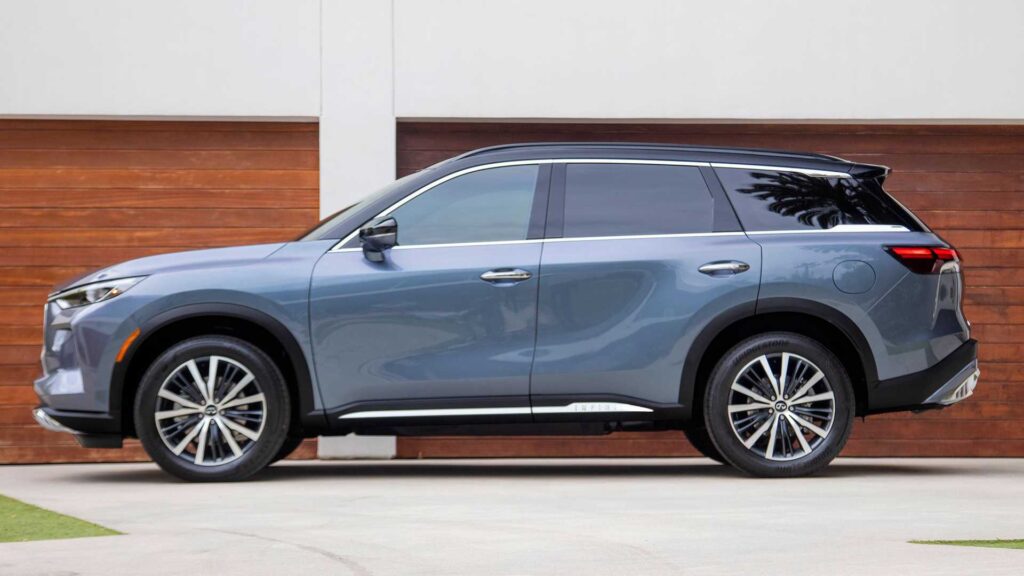Infiniti has unveiled its second generation QX60 crossover in Dubai. In general, this model traces its history back to 2012, when the Infiniti JX entered the market, later renamed QX60. However, this time it is really a completely new car: it has changed the design, interior, power plant and a lot of advanced electronic assistants.

Design Details
Talking about the design, describing its elements in detail, and even more so, giving it an assessment is a stupid and thankless occupation. Therefore, just look at the photos, compare with what happened before, and we will only point out the main features of the crossover, which Infiniti itself considers to be particularly successful.
So, the crossover is based on the QX60 Monograph concept car . These cars are very similar: both the silhouette of the body and the window line, as well as the drawings of the lighting technology and the radiator grill, have something in common.
According to Infiniti, the production crossover is painted in the new Moonbow Blue color, which “reproduces the deep blue and violet hues that cover the summer sky at dusk.” And if you translate these words of the chief designer of the brand Taisuke Nakamura into ordinary, not so romantic language, it means that special pigments have been added to the paint, which help, depending on the viewing angle, to change the color glare in the range from purple to green.
Exterior Details
According to Nakamura, the LED headlights are inspired by kimono folds, the mesh grille is inspired by traditional Japanese origami, and the leather upholstery of the dashboard and seats is inspired by ripples on a pond.
In addition to this, the car has a black roof and 20-inch wheels, which will be offered on most trim levels.
And if we completely move away from design concepts to dry boring numbers, then, say, the overall dimensions of the QX60 have not changed much. The wheelbase is generally the same – 2900 millimeters.
The length of the new QX60 is 5,034 millimeters (60 millimeters less than its predecessor), the width is 2,184 millimeters (but this, however, taking into account the mirrors), and the height is 1,770 millimeters (43 millimeters less than before). The ground clearance of the model in the American modification reaches 170 millimeters, while the ground clearance of the first generation cars sold in Russia is 187 millimeters.
Interior Details
The crossover has retained three rows and seven seats, but everything else has changed completely (except, perhaps, only a few buttons and knobs).
The photographs show the interior of a special modification of the Autograph, a feature of which is the separate captain’s seats in the second row. Freeing up the passage to the third row, they can move and recline in such a way that it will not be necessary to remove an already installed child seat.
The front seats are so-called “zero gravity” seats, developed by the Japanese in collaboration with NASA engineers. They are equipped with electric adjustments in eight directions, heating and massage with three programs.
Technics
The Infiniti QX60 engine remains the same – a 3.5-liter naturally aspirated “six” with direct injection, which produces 295 horsepower (in the US version; there is no data on the Russian version), but instead of a variator, it now uses a nine-speed automatic transmission.
The dynamic characteristics of the crossover have not yet been specified. The previous QX60 accelerated to “hundreds” in 8.2 seconds, and its top speed was 190 kilometers per hour.
The all-wheel drive system has been upgraded: the electronics can transfer up to 50 percent of the traction to the rear wheels, as well as brake and change the moment on each wheel to improve traction. In addition, an exclusively front-wheel drive version will be available in some markets, but again, it is not yet known exactly which cars they plan to sell in Russia.
Electronics
Infiniti QX60 received a new multimedia system with a 12.3-inch screen, wireless Apple CarPlay and Wi-Fi hotspot, adaptive headlights, front collision warning systems and automatic braking in front of obstacles behind the car, as well as advanced adaptive cruise control ProPILOT Assist.
It works in conjunction with navigation and traffic sign reading systems, adjusting the speed to the limits, and can also automatically decelerate before tight turns and decelerate the car until it comes to a complete stop, then resumes movement.



